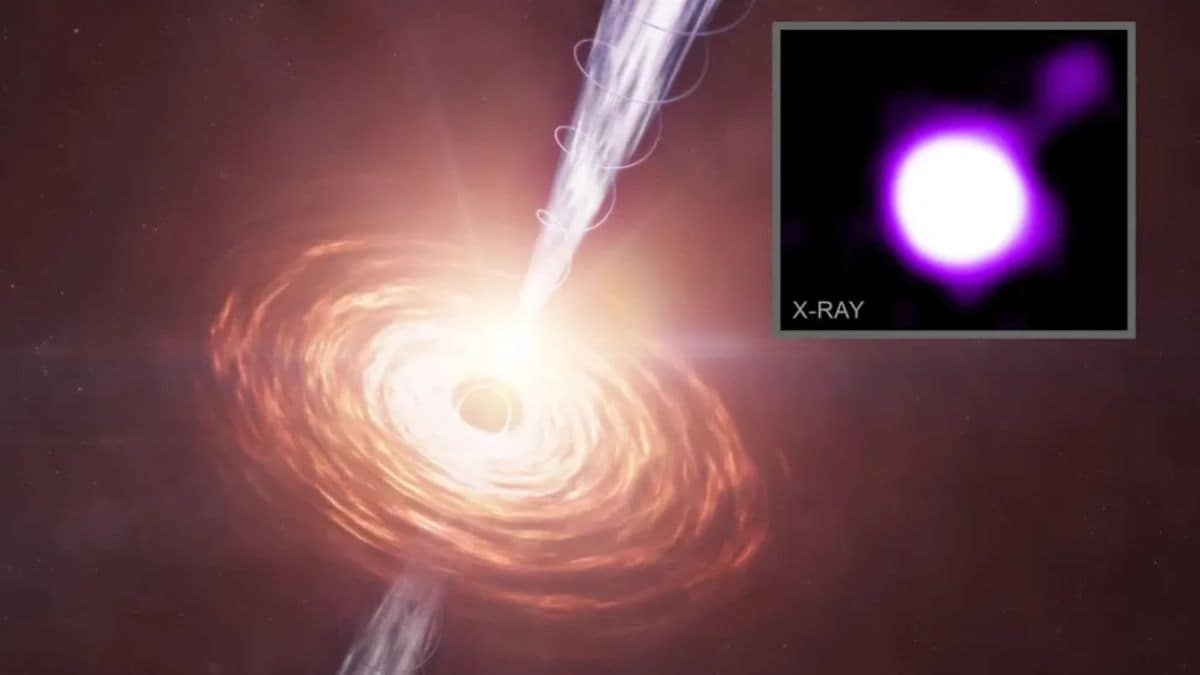
Contents
Unveiling the Cosmic Secrets: Chandra X-ray Observatory Detects Enormous X-ray Jet from Quasar J1610+1811
Imagine being able to witness the universe in its early days, when galaxies were still forming and black holes were actively shaping their surroundings. This is exactly what NASA’s Chandra X-ray Observatory has allowed us to do, with its latest discovery of an enormous X-ray jet from quasar J1610+1811, observed at a staggering distance of about 11.6 billion light-years. This incredible finding has shed new light on the universe’s "cosmic noon" era, roughly 3 billion years after the Big Bang.
The Discovery of the Distant X-ray Jet
The Chandra X-ray Observatory, with its high-resolution X-ray imaging capabilities, combined with radio data, has enabled a team of scientists to isolate the jet at such a great distance. The quasar’s distance means that the cosmic microwave background was much denser at that time, allowing relativistic electrons in the jet to efficiently scatter CMB photons to X-ray energies. By analyzing the multiwavelength data, the researchers have inferred that the jet’s particles are moving at an astonishing 92-98% of the speed of light. These near-light-speed outflows are among the fastest known, and they carry enormous energy into intergalactic space, providing a unique probe of how black holes influenced their surroundings during this critical period in the universe’s evolution.
The significance of this discovery cannot be overstated. X-ray jets like this one are thought to play a crucial role in shaping the universe as we know it, influencing the growth of galaxies and the distribution of matter and energy. By studying these jets, scientists can gain valuable insights into the fundamental processes that governed the universe’s early development.
The Importance of Chandra’s Continued Operation
However, the Chandra mission now faces a significant threat: NASA’s proposed budget calls for drastic cuts to its operating funds. For nearly 25 years, Chandra has been a cornerstone of X-ray astronomy, and its loss would constitute a major setback for the scientific community. The SaveChandra campaign warns that losing Chandra would be an "extinction-level event" for U.S. X-ray astronomy, crippling X-ray science and leaving a gaping hole in our knowledge of high-energy astrophysics.
Leading scientists have spoken out against the proposed cuts, emphasizing the devastating impact they would have on the field. Andrew Fabian, a renowned astrophysicist, expressed his horror at the prospect of Chandra being shut down prematurely, while Elisa Costantini warned that ending Chandra’s operation would "lose a whole generation" of scientists and leave a significant gap in our understanding of the universe.
The Future of X-ray Astronomy Hangs in the Balance
Without Chandra’s capabilities, many studies of the energetic universe would no longer be possible. The observatory’s unique X-ray imaging capabilities have allowed scientists to study black holes, neutron stars, and supernovae in unprecedented detail, revealing new insights into the universe’s most powerful phenomena. Chandra’s continued operation is essential for advancing our understanding of the universe, from the earliest moments after the Big Bang to the present day.
As we look to the future of space exploration and scientific discovery, it is crucial that we prioritize the continued operation of vital observatories like Chandra. The Chandra X-ray Observatory has been a shining example of scientific collaboration and innovation, and its loss would be a significant setback for humanity’s quest for knowledge and understanding of the universe. We must act to ensure that Chandra continues to thrive, driving new discoveries and pushing the boundaries of human knowledge for generations to come.
Key Takeaways:
- Chandra X-ray Observatory detects enormous X-ray jet from quasar J1610+1811 at a distance of 11.6 billion light-years
- The jet spans over 300,000 light-years and carries particles moving at 92-98% of the speed of light
- Chandra’s high-resolution X-ray imaging and radio data allowed scientists to isolate the jet at a great distance
- The cosmic microwave background was much denser at the quasar’s distance, enabling relativistic electrons to scatter CMB photons to X-ray energies
- Chandra’s continued operation is crucial for advancing our understanding of the universe, but its future is at risk due to proposed budget cuts
What’s Next:
- The scientific community awaits the outcome of the proposed budget cuts and the future of the Chandra X-ray Observatory
- Researchers continue to analyze the data from the quasar J1610+1811, seeking new insights into the universe’s early development
- The SaveChandra campaign rallies support for the observatory’s continued operation, emphasizing its vital role in advancing X-ray astronomy and our understanding of the universe.
Content originally published by www.gadgets360.com















